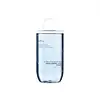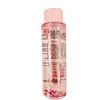What's inside
What's inside
 Key Ingredients
Key Ingredients

 Benefits
Benefits

 Concerns
Concerns

 Ingredients Side-by-side
Ingredients Side-by-side

Water
Skin ConditioningMethylpropanediol
Solvent1,2-Hexanediol
Skin ConditioningSea Water
HumectantGlycerin
HumectantBetaine
HumectantAllantoin
Skin ConditioningButylene Glycol
HumectantCaprylyl Glycol
EmollientEthylhexylglycerin
Skin ConditioningPanthenol
Skin ConditioningXanthan Gum
EmulsifyingMalachite Extract
AntioxidantDisodium EDTA
Hydrolyzed Hyaluronic Acid
HumectantPentylene Glycol
Skin ConditioningXylitylglucoside
HumectantAnhydroxylitol
HumectantSodium Hyaluronate
HumectantXylitol
HumectantPotassium Hyaluronate
Skin ConditioningGlucose
HumectantHydrolyzed Sodium Hyaluronate
Skin ConditioningSodium Acetylated Hyaluronate
HumectantHydroxypropyltrimonium Hyaluronate
Sodium Hyaluronate Crosspolymer
HumectantDimethylsilanol Hyaluronate
HumectantHydrolyzed Calcium Hyaluronate
Skin ConditioningHyaluronic Acid
HumectantSodium Sulfated Hyaluronate
EmollientHamamelis Virginiana Extract
AntiseborrhoeicChamaecyparis Obtusa Leaf Extract
Skin ConditioningSodium Stearoyl Hyaluronate
Skin ConditioningSodium Oleoyl Hyaluronate
Skin ConditioningWater, Methylpropanediol, 1,2-Hexanediol, Sea Water, Glycerin, Betaine, Allantoin, Butylene Glycol, Caprylyl Glycol, Ethylhexylglycerin, Panthenol, Xanthan Gum, Malachite Extract, Disodium EDTA, Hydrolyzed Hyaluronic Acid, Pentylene Glycol, Xylitylglucoside, Anhydroxylitol, Sodium Hyaluronate, Xylitol, Potassium Hyaluronate, Glucose, Hydrolyzed Sodium Hyaluronate, Sodium Acetylated Hyaluronate, Hydroxypropyltrimonium Hyaluronate, Sodium Hyaluronate Crosspolymer, Dimethylsilanol Hyaluronate, Hydrolyzed Calcium Hyaluronate, Hyaluronic Acid, Sodium Sulfated Hyaluronate, Hamamelis Virginiana Extract, Chamaecyparis Obtusa Leaf Extract, Sodium Stearoyl Hyaluronate, Sodium Oleoyl Hyaluronate
Water
Skin ConditioningPEG-40 Hydrogenated Castor Oil
EmulsifyingButylene Glycol
HumectantCentella Asiatica Leaf Extract
Skin ConditioningPolygonum Cuspidatum Root Extract
AntioxidantScutellaria Baicalensis Root Extract
AstringentCamellia Sinensis Leaf Extract
AntimicrobialGlycyrrhiza Glabra Root Extract
BleachingChamomilla Recutita Flower Extract
MaskingRosmarinus Officinalis Leaf Extract
AntimicrobialMadecassoside
AntioxidantPhenoxyethanol
PreservativeEthylhexylglycerin
Skin ConditioningLauroyl Methyl Glucamide
Skin ConditioningPentylene Glycol
Skin ConditioningParfum
MaskingCI 17200
Cosmetic ColorantWater, PEG-40 Hydrogenated Castor Oil, Butylene Glycol, Centella Asiatica Leaf Extract, Polygonum Cuspidatum Root Extract, Scutellaria Baicalensis Root Extract, Camellia Sinensis Leaf Extract, Glycyrrhiza Glabra Root Extract, Chamomilla Recutita Flower Extract, Rosmarinus Officinalis Leaf Extract, Madecassoside, Phenoxyethanol, Ethylhexylglycerin, Lauroyl Methyl Glucamide, Pentylene Glycol, Parfum, CI 17200
 Reviews
Reviews

Ingredients Explained
These ingredients are found in both products.
Ingredients higher up in an ingredient list are typically present in a larger amount.
Butylene Glycol (or BG) is used within cosmetic products for a few different reasons:
Overall, Butylene Glycol is a safe and well-rounded ingredient that works well with other ingredients.
Though this ingredient works well with most skin types, some people with sensitive skin may experience a reaction such as allergic rashes, closed comedones, or itchiness.
Learn more about Butylene GlycolEthylhexylglycerin (we can't pronounce this either) is commonly used as a preservative and skin softener. It is derived from glyceryl.
You might see Ethylhexylglycerin often paired with other preservatives such as phenoxyethanol. Ethylhexylglycerin has been found to increase the effectiveness of these other preservatives.
Pentylene glycol is typically used within a product to thicken it. It also adds a smooth, soft, and moisturizing feel to the product. It is naturally found in plants such as sugar beets.
The hydrophilic trait of Pentylene Glycol makes it a humectant. As a humectant, Pentylene Glycol helps draw moisture from the air to your skin. This can help keep your skin hydrated.
This property also makes Pentylene Glycol a great texture enhancer. It can also help thicken or stabilize a product.
Pentylene Glycol also acts as a mild preservative and helps to keep a product microbe-free.
Some people may experience mild eye and skin irritation from Pentylene Glycol. We always recommend speaking with a professional about using this ingredient in your routine.
Pentylene Glycol has a low molecular weight and is part of the 1,2-glycol family.
Learn more about Pentylene GlycolWater. It's the most common cosmetic ingredient of all. You'll usually see it at the top of ingredient lists, meaning that it makes up the largest part of the product.
So why is it so popular? Water most often acts as a solvent - this means that it helps dissolve other ingredients into the formulation.
You'll also recognize water as that liquid we all need to stay alive. If you see this, drink a glass of water. Stay hydrated!
Learn more about Water